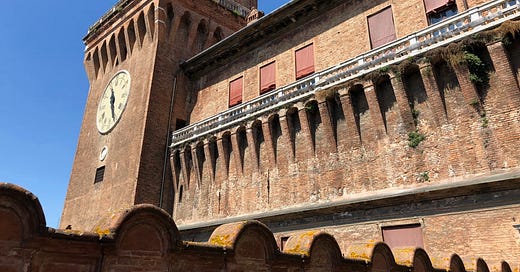The Jewish Doctors of Medieval Italy
How a small Italian city welcomed persecuted Jewish families in a search for doctors and wound up establishing one of Italy's most enduring Jewish communities
I wanted to take a pause from writing about medical education to mark the Passover holiday by telling one of my favorite stories from Jewish — and medical — history: the story of how Jewish people facing a latter-day exodus in the Middle Ages were able to find a surprisingly tolerant home in northern Italy, in the city of Ferrara.
Ferrara is a small city near Bologna in Emilia-Romagna, known for an immaculately preserved historic core punctuated by a castle with a bona fide moat, as well as the local specialty of cappellacci di zucca. Despite its close proximity to Bologna, it has largely avoided a place on the standard Italian tourist itinerary. And though visitors interested in Italy’s Jewish history more often head for the Venetian ghetto — or to Roman kitchens — it is Ferrara that Italy chose to host the nation’s laudable Jewish history museum.
That honor is due, in large part, to the fact that Ferrara’s ruling Este family welcomed Jewish arrivals at the end of the Middle Ages, during a period of widespread antisemitic persecution and forced migration. The community they founded survived uninterrupted in the city — with the benefit of aggressive civic protection — for centuries, until it was shattered by the SS in 1943.
The Jewish communities of Western Europe in the high and late Middle Ages were all too familiar with expulsion and antisemitism. In addition to their infamous exile from Spain in 1492, Jewish people were expelled from England in 1290 and from France three times in the fourteenth century alone. More fled Germany after a spate of thirteenth- and fourteenth-century massacres, spreading a new language — Yiddish — from its birthplace along the Rhine.
Many of these displaced communities migrated south through the Alps to northern and central Italy, where they converged with groups expelled from southern Italy after Spain took control of Sicily. Still, much of Italy proved no more welcoming. In the space of a decade in the late fifteenth century, Jewish residents were expelled from Florence, Milan, Parma, Perugia, Vicenza, and Lucca. In Rome, a series of popes welcomed Jewish arrivals — though not without imposing a significant tax burden — until antisemitic mob violence broke out in 1447 and 1455. It was not uncommon for Jewish Italians in this period to be forced to move between cities several times during their lives.
Ferrara, though, proved to be a more enlightened exception. In 1275, the ruling family issued a decree guaranteeing protection of Jewish residents on the grounds of their professional utility to the city. Fascinatingly, they were looking, above all, for doctors.
Aspiring Jewish physicians were barred from Italy’s medieval medical schools, so they were instead forced to train privately. That apprenticeship model proved to their advantage. Unlike their university-educated peers, who focused overwhelmingly on medical theory, Jewish doctors were quickly felt to be more adept at the procedural elements of the profession. Popes, princes, and other prominent Italians hired Jewish doctors to serve as their personal physicians, and Pope Pius II issued a proclamation allowing Jewish doctors to treat Christian patients throughout Italy.
Demand only increased in the aftermath of the Black Death, to the point that half of the doctors in the average Italian city were Jewish. There was, probably unsurprisingly, a financial advantage for their employers — the average salary for a Jewish doctor in this period was half that of a Christian one.
In Ferrara, the Este family made explicit that they were eager to welcome Jewish physicians, extending specific privileges to doctors and students. They went to lengths to defend their city’s Jewish community, applying for — and winning — papal approval of their presence, publicly ridiculing blood libel accusations during a period of antisemitic frenzy elsewhere in Italy, and authorizing the establishment of Ferrara’s synagogue. As word spread of Ferrara’s hospitality, Jewish families subject to ongoing expulsions elsewhere in Europe continued to descend on the city, swelling a population that would survive for another half-millennium. The last members of that community — whose final years were fictionalized in Giorgio Bassani’s classic Il giardino dei Finzi-Contini — are memorialized on a marble plaque beside the door of the surviving synagogue.




